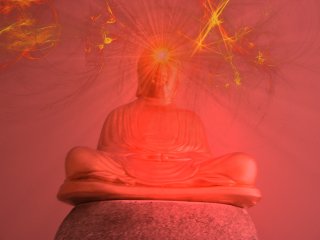Buddhism is growing apace in the United States, and an identifiably American Buddhism is emerging. Teaching centers and sanghas (communities of people who practice together) are spreading here as American-born leaders reframe ancient principles in contemporary Western terms.The numbers are from the American Religious Identification Survey of 2001. (The actual report, in Adobe Acrobat format, may be found here. )
Though the religion born in India has been in the US since the 19th century, the number of adherents rose by 170 percent between 1990 and 2000, according to the American Religious Identity Survey. An ARIS estimate puts the total in 2004 at 1.5 million, while others have estimated twice that. "The 1.5 million is a low reasonable number," says Richard Seager, author of "Buddhism in America."
That makes Buddhism the country's fourth-largest religion, after Christianity, Judaism, and Islam. Immigrants from Asia probably account for two-thirds of the total, and converts about one-third, says Dr. Seager, a professor of religious studies at Hamilton College, in Clinton, N.Y.
There are a number of interesting demographic facts about American Buddhists. In 1990, there were 401 000 (self-identified) Buddhists in the USA, and by 2001 that number had gone up to 1 082 000 (or approximately 0.5% of the country's total population). This is an increase of approximately 170%, as the article mentions.
Buddhism has a high rate of turnover. In 2001, 340 523 people (33%) who self-identified as Buddhists had switched in from another group, while 221 035 people (23%) had switched out from Buddhism to another group, with a net gain for Buddhism of 12%.
The report also distinguishes between identification and affiliation by examining household membership in a place of worship. Only 28% of Buddhists reported affiliation with a temple. The numbers range from a high of 83% for Evangelical/Born Again Christians to a low of 19% for "no religion", the only group with a lower percentage than Buddhists. (So about one fifth of Americans who claim to have "no religion" either belong to a secular organization that substitutes for a church, or attend the place of worship of a religion that they don't believe in.) I suspect that the percentage of Buddhists who participate in activities at a "place of worship" is being undercounted because Buddhist activities are not usually centred around a "place". Buddhists can get together to meditation, chant, or listen to a dharma talk not only at a temple or dharma centre, but at people's homes, rec centres, rented classrooms at a college or university, and so on. Many converts to Buddhism also tend to have multiple loose affiliations in that they may participate in the activities of various groups while not feeling strongly associated with any one of them.
In 2001, the marital status of American Buddhists are: 47% single, 7% single/co-habiting, 35% married, 8% divorced/separated, and 3% widowed. Buddhists have the highest percentage of people who are single. They also have the third lowest percentage of people who are married, after non-denominational Christians at 27% and those professing "no religion" at 19%.
A large number of Buddhists have family members belonging to another religion, with 39% of Buddhist adults living in mixed religion families. This is the second highest percentage after Episcopalians at 42%.
The ethnic make-up of American Buddhists is: 35% white, 4% black, 61% Asian, 2% Hispanic, and 1% other. Politically, American Buddhists vote: 9% Republican, 31% Democrat, 48% Independent, and 12% none/other.
In 2001, the age and sex distribution among adult American Buddhists was: 56% aged 18-29, 3% aged 65 and above, and 39% female. (For comparison, in 1990, the distribution was: 35% aged 18-29, 8% aged 65 and above, and 35% female.) Buddhists have the second highest percentage of people aged 18-29, after Muslims at 58%. Buddhists have the second lowest proportion of females, after Muslims at 38%. (This is unsurprising, since immigrants tend to be young and male, and most Buddhists and Muslims are immigrants.)
That's a lot of data and much can be said about it, but perhaps at another time.
南無阿彌陀佛

No comments:
Post a Comment